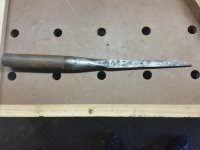Here is the traditional wisdom:
Mortise chisels have tall, square sides to help locate them in the mortise while you are cutting. Apparently someone who is good at cutting mortises can start a good square hole and then use the shape of the chisel to let the mortise cut itself. If that works for me on occasion, it's because of luck, but I don't do a lot of mortising either. On the flip side, if you don't start the hole right, the mortise can wander out of your lines. It takes practice, which I need more of :

. If you're not going to cut enough mortises by hand to get the practice, a mortising chisel might just make things harder. That's kind of where I'm at, to be honest.
The conventional wisdom that I've heard on chisel angles is 20-25 degrees for light paring chisels, 25-30 degrees for bench chisels, and 30-40 degrees for mortise chisels, assuming an additional 1-2 degrees for the secondary bevel. I recently got a set of PMV-11 bench chisels from Lee Valley (which I love so far) and they came with 30 degree angles on sizes less than 1/2", and 25 degrees on 1/2" sizes and greater. Their rationale is that the force of a mallet is concentrated on a smaller length of blade on the smaller sizes, and a steeper angle is need to protect the blade against the force. In my experience, whacking away on a mortise with a bench chisel really is harder on the edge. Plus I'm scared to just really let loose because I don't want to damage the handles.
At any rate, you want to pick an angle for a particular chisel and stick with it, as you don't want to be continually reshaping the bevel depending on what you're using them for - that's a quick way to end up with short chisels. So if you want a 35 degree angle on a mortise chisel, I'd bite the bullet and either get firmer chisels or mortising chisels for mortising. I use a Mk II narrow blade attachment from Veritas and it gives me very repeatable angles.
Mortise and firmer chisels also usually have some kind of hoop at the mallet end of the chisel to withstand heavier blows. Hoops just get in the way when you are trying to use a chisel by hand, so you won't find them on paring and bench chisels. Japanese bench chisels have hoops, and the tradeoff is that they are less comfortable to use by hand. That's why if you buy Japanese bench chisels, you are more likely to buy dedicated paring chisels after a while - to get the comfort of a chisel without a hoop for hand use.
You can cut a mortise with a bench chisel, but you don't get any help from the shape of the chisel, and you're putting a lot more stress on the edge of a chisel with a shallower ground than is optimal when you're really whacking on it.
On the other hand, if you're just cutting an occasional mortise, and don't get carried away with the whacking, then the video from danbox clearly shows that you can cut a good mortise with a bench chisel. I've done that as well.
BTW, I think the choice of steel is less critical for mortise chisels since the angles are steeper. I use Sorby mortise and firmer chisels ground to 35 degrees (~36 with micro-bevel) when I use them at all, and I've been happy with them. You can be more selective about sizes when buying mortising chisels - just buy the size(s) you need. That makes it easy to buy one chisel from one maker and see if you like it.



